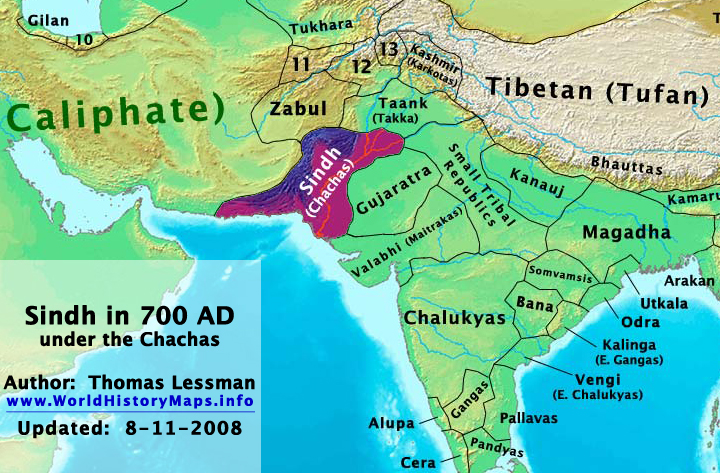
According to Tibri, Hazrat Ali had employed Jats to guard Basra treasury during the battle of Jamal. Jats were also the guards of the Baitul Maal at al-Basra during the time of Hazrat Osman. Amir Muawiya had settled them on the Syrian border to fight against the Romans.
Monitoring Desk
Before commencing a review of the Muslim period of Sindh’s history, we shall speak briefly of the Jats of Sindh province of Pakistan who were known all over Iran and the Middle East for their sturdy constitution and industrious nature. They have a colorful history and an adventurous past.
The author of Mujmaul Tawarikh has quoted an extinct Sanskrit work according to which the original inhabitants of Sind were Jats and Meds. Early Arab writers on Sindh also say that Jats and Meds were important tribes in their time. Ibn Khurdabah mentions ‘zutts’ as guarding the route between Kirman and Mansura while Ibn Haukal writes: “Between Mansura and Makran the waters from the Mehran form lakes and the inhabitants of the country are the south Asian races called Zutt. The Chinese traveller Yuan Chwang who visited this region in the 7th century A.D. also mentioned Jats.
According to the Encyclopedia of Islam, the Jats of the lower Indus comprise both Jats and Rajputs, and the same rule applies to Las-Bela where descendants of former ruling races like the Sumra and the Samma of Sind and the Langah of Multan are found. At the time of the first appearance of the Arabs they found the whole of Makran in possession of Jats (Zutts).
 According to a ‘Hadis’, Hazrat Abdulla Bin Masood, a companion Prophet saw some strangers with the Prophet and said that their features and physique were like those of Jats. This means that Jats we in Arabia even during the Prophet’s time. Hazrat Imam Bukhari (d. 875 A.D. – 256 A.H.) writing about the period of the Companions in his book “Al adab al Mufarrad” has stated that once when Hazrat Aisha (Prophet’s wife) fell ill, her nephews brought a Jat doctor for her treatment. We hear of them next when the Arab armies clashed with the Persian forces which comprised of Jat soldiers as well. The Persian Command Hurmuz used Jat soldiers against Khalid Bin Walid in the battle of ‘salasal’ of 634 A.D. (12 hijri). This was the first time that Jats were captured by the Arabs. They put forward certain conditions for joining the Arab armies which were accepted, and on embracing Islam they were associated with different Arab tribes. This event proves that the first group of Pakistanis to accept Islam were Jats who did it as early as 12 hijri (634 A.D.) in the time of Hazrat Omar.
According to a ‘Hadis’, Hazrat Abdulla Bin Masood, a companion Prophet saw some strangers with the Prophet and said that their features and physique were like those of Jats. This means that Jats we in Arabia even during the Prophet’s time. Hazrat Imam Bukhari (d. 875 A.D. – 256 A.H.) writing about the period of the Companions in his book “Al adab al Mufarrad” has stated that once when Hazrat Aisha (Prophet’s wife) fell ill, her nephews brought a Jat doctor for her treatment. We hear of them next when the Arab armies clashed with the Persian forces which comprised of Jat soldiers as well. The Persian Command Hurmuz used Jat soldiers against Khalid Bin Walid in the battle of ‘salasal’ of 634 A.D. (12 hijri). This was the first time that Jats were captured by the Arabs. They put forward certain conditions for joining the Arab armies which were accepted, and on embracing Islam they were associated with different Arab tribes. This event proves that the first group of Pakistanis to accept Islam were Jats who did it as early as 12 hijri (634 A.D.) in the time of Hazrat Omar.
The Persian King Yazdjard had also sought the help of the Sindh ruler who sent Jat soldiers and elephants which were used against the Arabs in the battle of Qadisia.
According to Tibri, Hazrat Ali had employed Jats to guard Basra treasury during the battle of Jamal. “Jats were the guards of the Baitul Maal at al-Basra during the time of Hazrat Osman and Hazrat Ali.” Amir Muawiya had settled them on the Syrian border to fight against the Romans. It is said that 4,000 Jats of Sindh joined Mohammad Bin Qasim’s army and fought against Raja Dahir. Sindhi Jats henceforth began to be regularly recruited in the Muslim armies.
“Some of the Zutt deserters from the Persian army were transplanted in 670 A.D. by Caliph Muawiya from Basrah to Antioch. When the Arabs conquered Sind, another batch of Zutts whom the conquerors had uprooted from their native pastures seem to have been sent to Syria by Hajjaj (691-713 A.D.) and eventually sent on by the Caliph Walid 1(707-15 AD) to join the previous batch of Zutt deportees at Antioch whence some, again, were sent on by the Caliph Yazid II (720-24 A.D.) to Massisah in Cicilia…. But the bulk of Hajjaj’s deportees from Sind seem to have been settled in Iraq. In the reign of Abbasid Caliph Mansur (813-33 A.D.) they broke into a rebellion which it took him and his successor Mutasim 833-42 AD), the best part of 20 years to quell….. Whether there had or had not been a voluntary immigration as well as a compulsory deportation of Zutt to Iraq from Sind, we may take it that in the course of the first two centuries of Arab rule, manpower from western subcontinent (i.e., Pakistan) had it in one way or another been pouring into a south-western Asia that, on the eve of the Arab conquest, had been depopulated by the two last and most devastating of the Romano-Persian wars.”
This statement of Tonybee is revealing in that it shows the close relations Pakistan had with the Middle East. Sindhis began to settle in areas as far away as Iraq and Syria which were depopulated by wars between the Persians and the Romans.
The origin of European gypsies is also traced to Sindhi Jats. Harun-ur-Rashid had recruited Jats to reinforce Cilician fortress. When the Romans descended on Ayn Zarbah in 855 A.D. they carried off into East Roman territory the Jats together with their women, children and buffaloes. This detachment of the Jats was the advance guard of the gypsies of Europe. They continued to pour into Europe in small batches at various stages subsequently.
_________________
Courtesy: Defence.pk
[…] Read: THE JATS OF SINDH […]